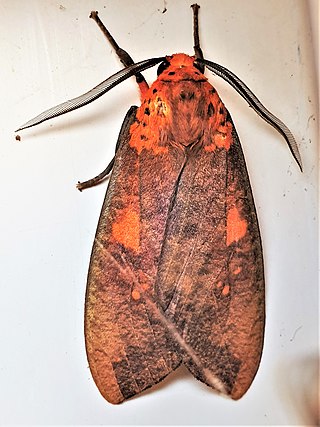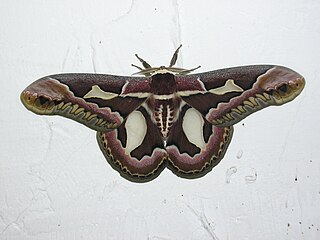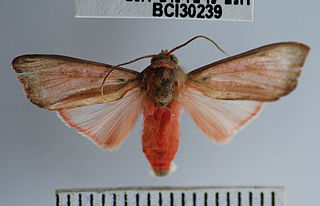
The cinnabar moth is a brightly coloured arctiid moth found as a native species in Europe and western and central Asia then east across the Palearctic to Siberia to China. It has been introduced into New Zealand, Australia and North America to control ragwort, on which its larvae feed. The moth is named after the red mineral cinnabar because of the red patches on its predominantly black wings. The species was first described by Carl Linnaeus in his 1758 10th edition of Systema Naturae. Cinnabar moths are about 20 mm (0.79 in) long and have a wingspan of 32–42 mm (1.3–1.7 in).

Ceratomia undulosa, the waved sphinx, is a moth of the family Sphingidae. The species was first described by Francis Walker in 1856. Also known as the "Scorpion Moth".

Psilogramma menephron, the privet hawk moth or large brown hawkmoth, is a member of the family Sphingidae. It was described by Pieter Cramer in 1780. It is usually found in Sri Lanka, India, Nepal, central and southern China, Thailand, Vietnam, Indonesia and the Philippines. Psilogramma casuarinae from eastern Australia was long treated as a synonym but is now thought to be a distinct species. The introduced population on Hawaii was first thought to be P. menephron, but is Psilogramma increta.

Psilogramma increta, the plain grey hawkmoth, is a moth of the family Sphingidae.

Apatelodidae, the American silkworm moths, is a family of insects in the order Lepidoptera. They are a family within the superfamily Bombycoidea, though they have in the past been considered a subfamily of Bombycidae.

Ammalo is a genus of moths in the subtribe Phaegopterina in the family Erebidae. The genus was erected by Francis Walker in 1855.
Melora is a monotypic moth genus in the subfamily Arctiinae. Its single species, Melora amygdaloides, is found in Brazil. Both the genus and species were first described by Francis Walker in 1855.

Psilogramma casuarinae, the Australasian privet hawk moth, is a moth of the family Sphingidae. The species was first described by Francis Walker in 1856. It is known from New South Wales, the Northern Territory and Queensland, all in Australia.

Rothschildia is a genus of moths in the family Saturniidae first described by Augustus Radcliffe Grote in 1896.

Dolbina inexacta, the common grizzled hawkmoth, is a species of moth of the family Sphingidae.

Rothschildia erycina, or Rothschild's silk moth, is a moth of the family Saturniidae first described by George Shaw in 1796. It is found from Mexico to Brazil and Paraguay. The habitat is tropical rainforest and wet savannah. It is found on altitudes of up to 1,200 meters above sea level.

Rothschildia jorulla is a species of moth in the family Saturniidae first described by John O. Westwood in 1854. This species is found in Mexico and Central America. Larvae feed on plants of a large number of families.

Rothschildia orizaba, the Orizaba silkmoth, is a moth in the family Saturniidae. The species was first described by John O. Westwood in 1854. It is found in Mexico, Central and South America.
Amaxia pardalis is a moth of the family Erebidae. It was described by Francis Walker in 1855 and is the type species of the genus Amaxia. It is found in Brazil, Suriname, Costa Rica and Mexico.

Eucereon pica is a moth of the subfamily Arctiinae, described by Francis Walker in 1855. It is found in Costa Rica, Peru and Rio de Janeiro, Brazil.
Lepidokirbyia vittipes is a moth of the family Erebidae first described by Francis Walker in 1855. It is found in Panama, Brazil, Suriname, Paraguay, Ecuador, Peru and Colombia.

Melese incertus is a moth of the family Erebidae. It was described by Francis Walker in 1855. It is found in French Guiana, Suriname, Guyana, Brazil, Venezuela, Trinidad, Peru, Bolivia and Panama.
Quentalia vittata is a moth in the family Bombycidae. It was described by Francis Walker in 1855. It is found in Brazil.
Rothschildia forbesi, the Forbes' silkmoth, is a species of silkmoth in the family Saturniidae.













